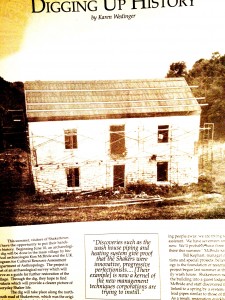Ace June 1991
“Discoveries such as the wash house house piping and heating system prove that the Shakers were innovative, progressive perfectionists.”
Tis a Gift to Be Simple: Digging Up Shakertown 170 years later
by Karen Wedinger
This summer, visitors at Shakertown will have the opportunity to put their hands into history. Beginning June 10, 1991, an archaeological dig will be done in the main village by historical archaeologist Kim McBride and the UK Program for Cultural Resource Assessment Department of Anthropology. The project is part of an archaeological survey which will serve as a guide for further restoration of the village. Through the dig, they hope to find artifacts which will provide a clearer picture of everyday Shaker life.
The dig will take place along the north-south road of Shakertown, which was the original main road before their chief engineer, Macajal Burnett, decided it would be better to align the village east-west. The project will basically follow a conjectural map based on Shaker journals. According to McBride, “Evidence of the number and layout of the original structures along the north-south road is what we’re really interested in at this point. And to learn the degree of preservation for planning purposes. Our thrust right now is to do a survey of the upper village for management purposes, so that they know which areas are sensitive archaeologically and should be left undisturbed. And maybe there are areas which should be excavated around and exposed for exhibition purposes.”
In addition to McBride, her assistants and the archaeology field school, there will be as many as eight visitor volunteers working at the site at any given time. “I feel like it’s important that we share what we are doing with the public. In fact, that will be something that our students will be doing, explaining what we’re doing to the public and officially assigning people to do that sort of thing,” said McBride. To keep things under control, a maximum of eight volunteer visitors may work with the archaeological team at any given time. Interested parties should plan to register. As for the students selected for the project, “We like people to have a few anthropology classes, but they don’t really have to as long as they have some interest in archaeology and are able to handle some physical work. They have to be a UK student or apply to the university and be accepted as a transfer. And we have some coming from other colleges as well. But we try to take in as many as we can. In fact, this year, we think we have too many for one assistant. So instead of turning people away, we are trying to get another assistant. We have seventeen and eighteen right now. We’ll probably have three paid people out there this summer,” McBride said.
Bill Kephart, manager of river operations and special projects, believes “Archaeology is the foundation of restoration.”
The project began last summer at the West Lot family wash house. Shakertown needed to convert the building into a guest lodging suite when McBride and staff discovered the building was linked to a spring by a system of underground lead pipes similar to those of the main village. As a result, restoration quickly gave way to excavation, according to Kephard. Digging through three feet of mud, gravel and 1880s-1890s artifacts, Kim McBride and her staff finally found the stone floor of the West Lot wash house. The house was built on a stone foundation and contains the remains of a heating system for washing clothes. The challenge now is for Shakertown to preserve these discoveries while utilizing the building as guest lodging.
Discoveries such as the wash house piping and heating system give further proof that the Shakers were innovative, progressive perfectionists. Their pride in workmanship is now a kernel of the new management techniques American corporations are trying to instill. According to Kephart, “They had a great deal of pride in their work. And everyone says that now Americans have to learn again to take pride in what we do. And the Shakers could help us learn that, to be proud of every little thing we turn out and stop trying to take shortcuts for the sake of the dollar. Somehow the idea got through to them that everything I do is important and I’m worth something; therefore if I’m making this little spindle, I am going to do it perfectly.”
The project is paid for by a $23,000 grant from the Kentucky Heritage Council, and has additional support from the University of Kentucky and Shakertown at Pleasant Hill. The goal of the Council is for Shakertown to make archaeological investigation a policy. “We want to assist the trustees in interpreting Shakertown because, being so well restored and interpreted, it is one of the most important landmarks in Kentucky,” David Morgan, director of the Council, asserted.
Kephart’s interpretation of Shakertown has particular relevance to 20th century America. “Obviously there are no direct contemporary religious, social, cultural influences by Shakerism. Not that the potential is not there. I think the Shakers deserve more study because I think we can learn from them. The people who were Shakers were not pansy aesthetes; they were viril people. They were not emasculated in any way. The success of the Shaker life signifies very clearly the victory of such attributes as respect for women. From the very beginning, women were on an absolute par with men. Big theme number one: how to feel good in a society where the sexes are equal.”
“The second big theme is pacifism,” he continued. “Thousands of them lived in a peaceful society and learned how to live in the midst of an angry world. The most dramatic event was the Civil War.”
During the Civil War, it was standard policy for troops to pillage farms as they passed through for supplies. Both Confederate and Union troops moved through the Pleasant Hill area during the war. The Shakers fed them willingly although they were against war, and as a result, all that was stolen from their hundreds of thousands of dollars’ worth of property were a few sweet potatoes, a few rails and palings taken from the fences. One of the journals recorded an incident when a calvalry from the west foraged their horses in the cornfield. however, according to the journalist, “They had not been through our village before to experience our generosity. Had they been, they would not have done this.”
“Third, and probably most difficult,” said Kephart, “is learning an alternative to private ownership. Our entire way of life is built on ‘This is mine’ or ‘That’s yours yours, but I want it,’ or ‘This is mine, and if you want it, this is how much it will cost you.’ The Shakers, and we don’t know where this came from historically, but somewhere they came up with the idea of joint ownership or communalism.”
The final theme of Kephart’s interpretation is learning to confess our shortcomings freely and then celebrating our freedom from them together — recognizing our human frailties and shortcomings, rather than supporting the pretense that some are better or purer than others.
“I really believe that the Shakers concentrated on, focused on, some of the very things that we are still trying to figure out today. And they did it so well, they were so successful, that that’s the significance of this place.” Pointing to the Shaker meeting house, he finished, “That’s the significance of that building right there; in its simplicity, in its symmetry, in its functionalism. The fact that 170 years later, that building is beautiful. In fact, it has lines that enable it to be studied by contemporary architectural students, and some elements of it can be used in contemporary design.”







